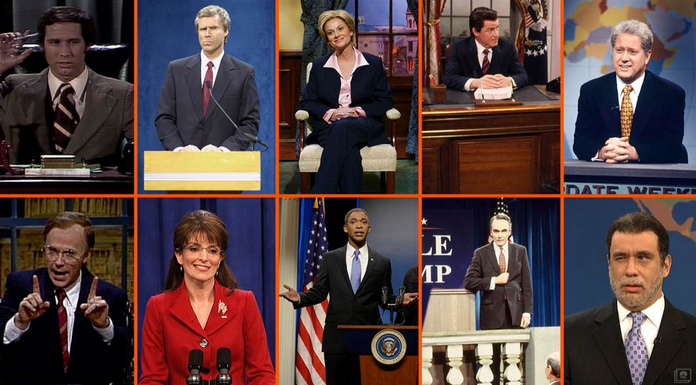Saturday Night Live and politics: Friends with benefits
From Ford to Obama: four decades of poking fun at our leaders (NBC News Screenshot)
For the past four decades, Saturday Night Live and American politics have enjoyed a beautiful friendship.
Well, sort of.
At times, the love may appear a bit one-sided, especially when certain, less “flattering” impressions gain momentum. Still, it’s hard to imagine the two not hand-in-hand, especially during election years.
Political events supply SNL’s writers with a golden bounty of material to work with. And while the show’s core purpose has always been to make us laugh, the side effects of humor have proven their influence within the political process, as candidates have learned to take advantage of comedy’s reach.
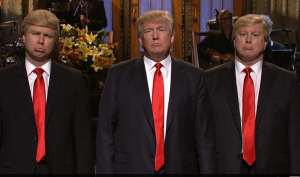
Appearances on SNL by the 2016 runners are already in full swing, with Donald Trump hosting in early November and Hillary Clinton opening season 41 as a bartender serving, well, herself. Though, historically, candidates haven’t always jumped at the chance for a cameo, presidential parody on SNL is as old as the show itself.
“SNL’s political satire really started with Chevy Chase’s pratfall routine of a clumsy President Gerald Ford, falling up and down the Air Force One stairs,” said Thomas J. Madden, former Vice President of NBC (now Chairman and CEO of Transmedia Group, an international PR firm). Since then, “few other politicians were spared.”
Soon after the debut of the faux Ford, the real Ford appeared on the show to deliver its famous introduction, “Live from New York, it’s Saturday Night!” With that, said authors James Andrew Miller and Tom Shales in their book, Live From New York, Ford began a “new tradition” of politicians joining in on the jokes, and “presidential politics would, as the saying goes, never be the same.”
With each passing election since 1976, SNL has introduced America to a new ensemble of political “replicas” — like Darrell Hammond’s predatory, thumbs-upping Bill Clinton, Phil Hartman’s “Ronald Reagan: Mastermind” and Tina Fey’s simple-minded Sarah Palin (an impression that, in Miller and Shales’ book, she called “less than ideal”).
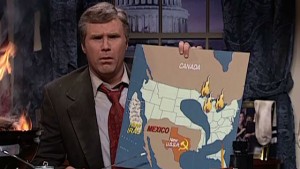
With its infusion of so many iconic personalities and punchlines into the pop culture sphere — from Dana Carvey’s George H.W. Bush (“Na ga da!”), to Will Ferrell’s Dubyah (“Strategery!”), to Fey’s infamous, “I can see Russia from my house” — SNL has become a time-honored political tradition, itself.
Humor is no laughing matter
Political parody, and comedy in general, plays a more important role than it’s sometimes given credit for.
“Humor provides us with a shared sense of meaning surrounding large events,” said Dannagal G. Young, associate professor of communication at the University of Delaware and scholar of political humor. Political satire, specifically, “allows us, as citizens, to laugh at and poke fun at people and institutions in power, in safe ways that elucidate and inspire.”
Indeed, loudly mocking a candidate’s appearance or weird speech pattern from a debate audience is, as they say, a “no-no.” But, SNL has established itself as a reliable, weekly outlet for viewers not only to laugh at, but to process all of the many signals thrown at them during elections.
While some may argue that the show favors one party’s signals over the other, writers say that they aim to be equal-opportunity ridiculers.
“When it’s the political stuff, it’s best when somebody who’s a Democrat goes, ‘oh, you really gave it to Bush,’ and somebody who’s a Republican will go, “oh, you really laid into Gore.’ That’s the reaction we should be getting,” said Steve Higgins, longtime SNL writer and producer, in Live From New York.
“It’s the most fun when the tone is silly and there’s no anger, and our stance is wise-ass, uninvolved detachment,” said comedian and established SNL writer James Downey in the book.
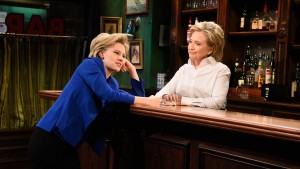
Candidates from concentrate
Anyone keeping up with season 41 has already gotten to know Kate McKinnon’s high-strung, crazy-eyed Hillary Clinton, Jay Pharoah’s dead-eyed Ben Carson, Taran Killam’s charming but hopeless Martin O’Malley and Larry David’s guest-spot as a wildly gesturing, grumpy-old-man Bernie Sanders.
“SNL has a way of digesting [politicians] down to their most flawed and humorous essence,” said Young. But, occasionally, those condensed versions take on a life of their own, and stick to viewers’ memories like glitter on glue (or gum on a sneaker, depending on who you ask).
President Ford, for instance, “was a gifted athlete and really no klutzier than anyone else,” said Alan Schroeder, journalism professor at Northeastern University and author of multiple books on the impacts of show business on politics. But, unfortunately for the 38th President, “Chase’s impression of him as someone who constantly fell down, knocked things over, et cetera, left a lasting impression that lingers to this day.”
Audiences have seen the SNL effect on politicians repeated time and again. Even when the impression is bizarre and far-stretching, it often burrows snuggly into viewers’ political consciousness.
Dana Carvey’s squinting, snickering, non-enunciating George Bush Sr., for example, bears only a spotty resemblance to Bush himself. But, the imitation occupies a seat in many memories that’s right next to the President himself — particularly for younger fans, who’ve spent much more time viewing SNL reruns than old speeches.
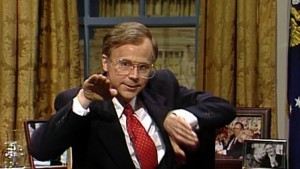
In Carvey’s impression, it’s not an exact physical likeness, but “the frenetic nature of his changing subjects, interrupting himself, using bad syntax and WASP jargon [that] really nails it,” said Mary Kate Cary, former speech writer for President George H.W. Bush (and Producer of the documentary, 41ON41, in which she interviews 41 notable names — including Carvey — about their experiences with the President).
Seeing double: The Palin saga
While some SNL parodies earn the biggest laughs from the performers’ use of creative license, some kill it with spot-on impression, alone. One act in particular mirrored a candidate so sharply, creating a character so eerily familiar, that it had viewers almost as confused as they were entertained.
Tina Fey’s impression of Sarah Palin, John McCain’s running mate in 2008, was an unexpected study in the powers of parody.
During SNL’s 34th season premiere, Fey (already an SNL alumna) took to the stage for the first time as Palin. As she recalls in her 2011 autobiography, Bossypants, she was “skittish to do political comedy” at the time, but hesitantly accepted the request of SNL’s creator and executive producer, Lorne Michaels, in a last-minute decision. In the following weeks, she and Palin would both become “the carrageenan in American’s news nuggets,” and the rest is history.
In that first sketch, Fey appeared beside Amy Poehler as Hillary Clinton, unnerved at Palin and struggling to keep her composure. Fey’s natural resemblance to Palin meshed with precise copies of her makeup, hair, clothing and dialect to create a spitting image of the VP candidate that turned heads, on its own (“Even today, I do a double-take,” said Palin in Live From New York, when she catches glimpses of Fey as herself. “I think, ‘what am I doing on TV today?’”).
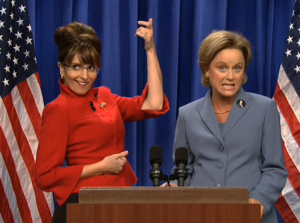
However — in this sketch and those that followed — it was her “beauty queen” body language, obtuse commentary (“I believe that [global warming] is just God hugging us closer!”) and largely verbatim mimicking of Palin that truly sparked the image of an air-headed bimbo that, for many, first defined the Alaskan Governor.
Though Fey denies any intention to actually hurt Palin’s reputation, “no parody on SNL has been more devastating, because Fey’s impersonation came just as Palin was introducing herself to the American public,” Schroeder said.
“Fey would achieve the impressionist’s dream: She would become arguably more famous than the person she was impersonating,” Miller and Shales said in their book.
But, did the impression actually have an impact on the 2008 election? Could one comedian have possibly changed the course of political history with a pantomimed rifle-cocking and a wink? Were there any proven consequences of Fey’s performance on voting behaviors that year?
“None that are actually documented,” said Young, “though media effects are notoriously difficult to measure.”
“SNL is egotistical if they believe that it was truly an effect [on] the public debate about who should lead the country,” said Palin in the book.
She may be right, but perhaps not for the reasons she’d hope.
Young was involved in a study on this very subject, which determined that “exposure to both Tina Fey’s parodies of Palin and the original Palin interviews both had the same result: they primed Palin’s negative attributes in peoples’ minds,” she said.
In other words, while some may blame Fey for Palin’s lack of voter support that year, it’s important to remember that the Governor played a considerable part in it, herself.
http://www.hulu.com/watch/36863
Fey and Poehler as Palin and Couric, in a partially verbatim parody of their 2008 interview
If you can’t stop’em, join’em.
In SNL’s early years, “politicians weren’t as interested in comedy and satire as they are today, nor were the satirists as interested in politics,” said Madden, who served as VP at NBC in the early 80s.
But, as evidence of the show’s broad voice grew, so did politicians’ enthusiasm to use it as a “strategeric” tool — from candidates signing on to host, to walk-ons from standing Presidents.
Some of today’s candidates, Madden said, “would give a PAC’s million bucks to host SNL.”
“I would argue that SNL has as much impact on younger Americans as any other aspect of a political campaign,” said John McCain in Live From New York.
“One of the highlights, frankly, of my political career was when I was able to host SNL,” said McCain, who’s appeared multiple times. “Despite the failure of the campaign, it was probably the best way I knew to gain communication with the younger voters, who certainly didn’t watch the debates … it was an incredibly useful way to get in touch with them.”
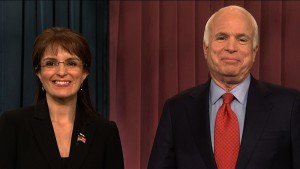
Even Al Gore, whose “advisers actually made him sit down and watch the SNL parody of one of his 2000 debates … to show how poorly he was coming across,” Schroeder said, could appreciate the humor.
“It did have an effect … and I thought it was very funny,” Gore said in the book.
Of course, not all politicians have approached this “rite of passage” with as much amusement.
“Here you have this serious presidential campaign, and all of us had to go on these comedy shows … because that was the only way we could have more than a sound bite and reach a large audience,” said Ralph Nader (who ran for the Green Party in 2000) in the same chapter.
The merits of being a good sport
As useful to candidates as SNL’s power of exposure is its power to bring them down to Earth in the eyes of voters.
“Because issues in presidential races are so complicated, many voters make their choices on personality — who they like best, who they’re most comfortable with,” said Kent Syler, assistant professor of political science at Middle Tennessee State University (as well as political strategist and analyst, and former Campaign Manager and Chief of Staff for Tennessee Congressman Bart Gordon).
Shows like SNL “help candidates break through the clutter, allowing them to show a more human side,” Syler said.
And, he pointed out, with so much money and airtime devoted to ads aiming to “demonize and disqualify” those on both sides, these appearances are “more important than ever,” as they give candidates a chance to show that they aren’t actually, as some ads would like voters to believe, the devil him(or her)self.
“The danger for politicians who go on comedy shows is that they are playing in somebody else’s sandbox, by somebody else’s rules. It’s not as easy as it looks,” Schroeder said.
But, “there’s a lot to be said for not taking life too seriously and having a good laugh,” said Cary. “There’s not a lot of humility in politics today,” and appearing on shows like SNL “shows that you are humble and have a sense of humor, and not many people in politics these days have both of those qualities.”
By many accounts, the first President Bush, in particular, has been an absolute champ at rolling with the punches.
When he was President, “he knew that political satire comes with the territory,” said Cary. “His favorite jokes were self-deprecating [and] he considered Carvey’s impersonation of himself to be a badge of honor, a great way to poke fun at himself and soften his image.”
As Carvey recalls in Live From New York, Bush showed his appreciation by inviting he and his wife for an overnight at the White House. “It’s still one of the peak experiences and most mind-blowing experiences of our life,” Carvey said. “He sort of just charmed the pants off us.”
“They became great friends,” said Cary, and “have done a tremendous number of charity appearances together,” since.
Of course, even the funniest, most sportsman-like cameo won’t necessarily tip voting scales, or erase criticisms of a candidate from viewers’ minds. But, the strength to take a joke serves as a valuable reminder to voters that they’re electing a person, and not a character, after all.
“SNL has been a driving force in puncturing pontificating, and making candidates laugh at themselves,” Madden said.
And, that’s “probably the most human thing you can do.”
http://www.funnyordie.com/videos/f5a57185bd/funny-or-die-s-presidential-reunion
Carvey, Ferrell, Chase and others revive their presidential roles for a Funny or Die short

Lauren Molander, a Baltimore native, is on a long-winded journey to find her place in the world. She majored in Media and Communications Studies at UMBC, and hopes to build a career working with words.
Lauren is unusually enthusiastic about roller coasters, SNL, fancy teas, cosplay culture and the broody music of her early teenage years. In her free time, she can be found playing with makeup, beating the same video games repeatedly, begging her cats for affection, reading books by funny people and binging on anime.
She is still waiting patiently for her (tragically delayed) letter from Hogwarts.

